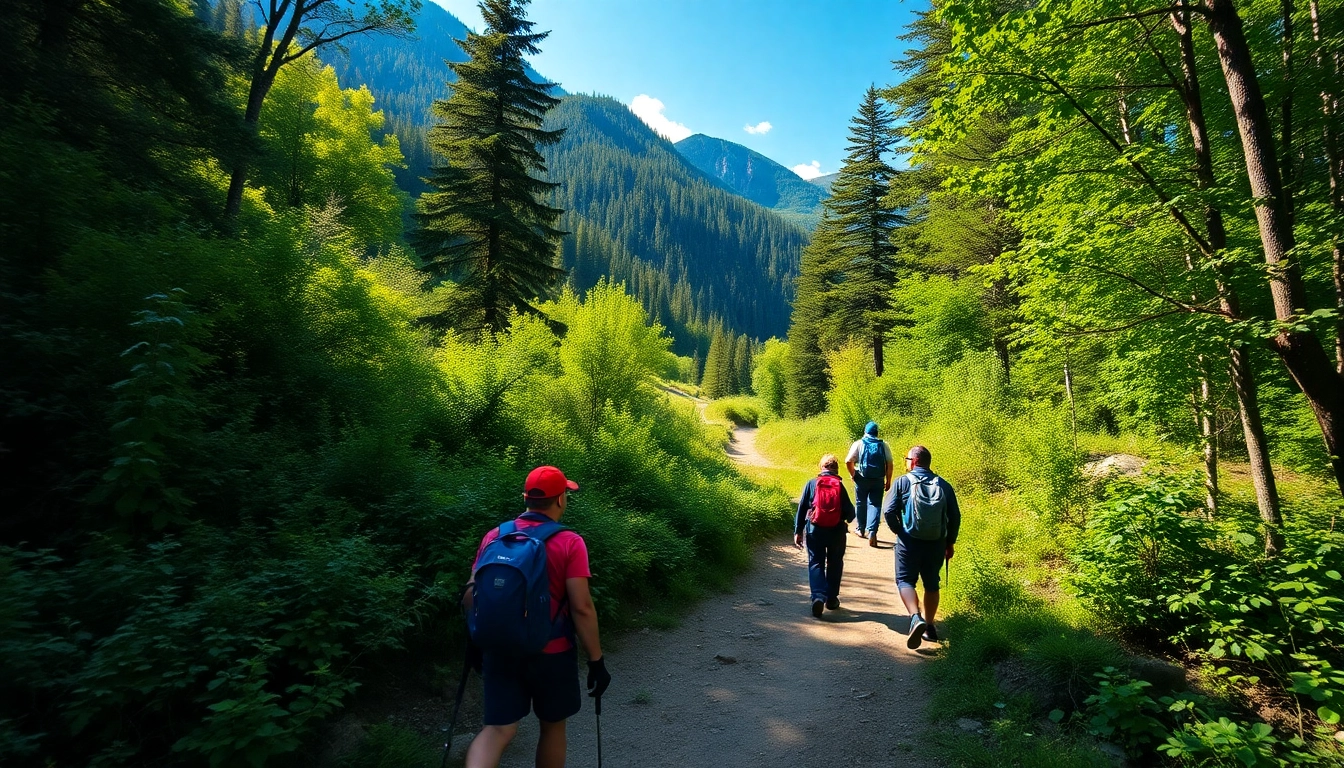Introduction to Hiking and Its Significance
In recent years, outdoor activities have gained immense popularity as people seek healthier lifestyles, mental clarity, and a deeper connection with nature. Among these activities, hiking stands out as a universally accessible and beneficial pursuit. Whether in lush forests, rugged mountains, or scenic trails, hiking offers not only physical exercise but also mental rejuvenation. This comprehensive guide aims to explore the nuances of hiking, provide practical insights for beginners, highlight the best destinations in Indonesia—particularly Lombok—and underscore the myriad benefits that make hiking a valuable addition to your lifestyle.
Pengenalan Dasar tentang Hiking dan Perbedaannya dengan Trekking
Apa itu Hiking? Definisi dan Asal Usulnya
Hiking is defined as a long, vigorous walk in natural environments, typically along designated trails or footpaths. The activity can range from short nature walks to extensive multi-day adventures, depending on the terrain and individual preference. Historically, hiking has roots in European outdoor recreation during the 18th century, evolving from simple walks in rural landscapes to a structured activity embraced globally. Its core purpose is to foster physical fitness, mental well-being, and a profound appreciation for nature. Today, hiking is recognized as a low-cost, accessible form of exercise that requires minimal equipment, making it popular among all age groups.
Perbedaan Hiking, Trekking, dan Walking
While these terms are often used interchangeably, they have distinct meanings and implications. Hiking involves walking on established trails or footpaths, which may vary in difficulty, but generally is a recreational activity designed for enjoyment and health benefits. Trekking, on the other hand, is a more intense, multi-day journey through remote and rugged terrains, often requiring camping and carrying supplies. Walking refers to casual strolls on flat, well-maintained surfaces such as pavements or park pathways, primarily for leisure or commuting. Understanding these differences helps enthusiasts choose the activity that aligns with their health, skill level, and adventure aspirations.
Manfaat Utama Hiking bagi Kesehatan dan Mental
The benefits of hiking extend far beyond physical activity. Regular hiking can improve cardiovascular health, increase stamina, and strengthen muscles. Mental health benefits are equally profound, including reduction in stress, alleviation of depression, and boost in mood through exposure to natural settings. Scientific studies have highlighted that outdoor walks stimulate the production of endorphins—nature’s mood enhancers—helping reduce anxiety and promote relaxation. Hiking also encourages mindfulness, as engaging with nature elevates awareness and presence. Overall, hiking supports a holistic approach to healthier living, fostering resilience, mental clarity, and emotional balance.
Cara Memulai Aktivitas Hiking di Indonesia
Pilihan Destinasi Hiking Terfavorit di Lombok dan Sekitarnya
Indonesia, with its diverse landscapes, offers myriad options for hiking enthusiasts. Lombok, in particular, has become a top destination for hikers seeking adventure and scenic beauty. Iconic spots include Mount Rinjani, Indonesia’s second-highest volcano, offering challenging treks with breathtaking vistas and a rewarding crater lake. Other popular destinations include the lush waterfalls in Senaru, the green slopes of Mount Sumbung, and the pristine beaches accessible via coastal hikes. These locations cater to various skill levels, from beginner-friendly trails to complex multi-day expeditions. Planning your trip involves selecting the right trail, season, and ensuring adequate preparation for a safe and enjoyable experience.
Perlengkapan Dasar dan Tips Keamanan saat Hiking
Proper gear is essential for a safe hike. This includes durable hiking shoes, weather-appropriate clothing, a sturdy backpack, navigation tools (maps, compasses, GPS), and safety equipment such as first aid kits and multi-tools. Hydration and nutrition are equally critical; packing sufficient water and energy-rich snacks ensures stamina during the trek. Safety tips encompass informing others of your itinerary, checking weather forecasts, and being mindful of the terrain. Awareness of potential hazards such as loose rocks, slippery paths, or sudden weather changes can prevent accidents. Additionally, respecting local regulations and environmental guidelines helps preserve the natural beauty of hiking destinations.
Tips Persiapan Fisik dan Mental untuk Pemula
For beginners, physical preparation involves regular cardiovascular exercises like walking, jogging, or cycling to build endurance. Strengthening core muscles and practicing balance can improve stability on uneven paths. Mentally, cultivating patience and a positive mindset are vital, especially when facing challenging terrains or unpredictable circumstances. Starting with shorter, less difficult trails allows gradual acclimatization. Additionally, engaging with local outdoor communities or guided tours can enhance confidence and knowledge. Being well-prepared physically and mentally ensures that hiking remains a safe and enjoyable activity while minimizing risks and fostering a sense of accomplishment.
Strategi Menikmati Hiking dengan Optimal dan Aman
Cara Mengatur Rute dan Waktu Tempuh
Effective route planning is fundamental for a successful hike. Select trails that match your fitness level and experience, considering distance, elevation gain, and trail difficulty. Use maps or GPS tools to plot your route, and always have alternative plans in case of emergencies or changing conditions. Timing also plays a crucial role; start early to maximize daylight hours, avoid peak heat, and allow sufficient time to complete the hike comfortably. Incorporate rest breaks and monitor your energy levels to prevent exhaustion. Consulting local guides or experienced hikers can provide valuable insights into optimal routes and timing strategies.
Teknik Memanfaatkan Peralatan Pendukung
Utilizing the right equipment enhances safety and comfort. Trekking poles help reduce stress on joints and improve balance on steep slopes. High-quality footwear prevents blisters and injuries, while layered clothing allows adjustment to temperature fluctuations. GPS devices, altimeters, and compasses assist in navigation, especially in unmarked areas. Portable power banks, headlamps, and emergency whistles are additional support tools. Regular maintenance of gear and knowing how to use each item effectively is critical for a smooth hiking experience. Training in equipment handling and navigation skills should be part of your preparation routine.
Perawatan Tubuh dan Lingkungan Saat Hiking
Maintaining your health during hikes involves hydration, proper nutrition, and pacing yourself. Protect your skin with sunscreen and insect repellent, and wear appropriate clothing to prevent abrasions and sunburn. Listening to your body and taking rest when needed are essential to avoid fatigue. Environmental stewardship is equally important; adhere to ‘Leave No Trace’ principles by packing out all trash, staying on designated trails, and avoiding damage to flora and fauna. Respect local communities and wildlife, and minimize your ecological footprint to ensure that natural sites remain pristine for future generations.
Understanding the Health and Mental Benefits of Hiking
Efek Positif Fisik dari Berjalan di Alam
Walking in natural environments enhances cardiovascular health by increasing heart rate and improving circulation. Regular hiking contributes to weight management, muscle strengthening—particularly in legs, core, and back—and boosts overall stamina. The varied terrain activates different muscle groups, promoting balanced physical development. Moreover, hiking improves bone density through weight-bearing activity and enhances flexibility and coordination. Studies have also linked outdoor walking with better immune function, thanks to increased exposure to fresh air and sunlight, which boosts vitamin D production.
Hiking untuk Reduksi Stres dan Peningkatan Mood
Immersing oneself in nature reduces stress hormone levels and fosters relaxation. The tranquil environments, combined with rhythmic walking, promote mindfulness and mental clarity. The sight of greenery, the sound of flowing water, and fresh air stimulate sensory engagement, aiding in emotional regulation. Mental health benefits include reduced symptoms of anxiety and depression, improved sleep quality, and greater overall well-being. Many therapists now incorporate outdoor activities like hiking into treatment plans for stress management and trauma recovery, emphasizing its therapeutic potential.
Hiking Sebagai Bagian dari Gaya Hidup Sehat
Integrating hiking into daily or weekly routines supports long-term health and vitality. It encourages a balanced lifestyle encompassing physical activity, outdoor exposure, and social interaction when done in groups. Tracking progress, setting achievable goals, and participating in community hikes foster motivation and accountability. Complemented with proper nutrition and sufficient rest, hiking practitioners often report increased energy levels and a stronger sense of purpose. As part of a holistic healthy living approach, hiking can profoundly improve quality of life, making it a sustainable and enjoyable health practice.
Strategi Meningkatkan Pengalaman Hiking melalui Komunitas dan Berkelanjutan
Membangun Komunitas Pecinta Alam di Indonesia
The growth of outdoor activity communities in Indonesia has strengthened the spirit of conservation and shared adventure. Joining local hiking clubs or online forums provides access to valuable knowledge, safety tips, and group expeditions that cater to various experience levels. These communities foster camaraderie, mutual support, and environmental awareness, promoting sustainable practices and cultural exchange. Organizing regular educational events about local flora, fauna, and conservation efforts enhances overall awareness, creating a passionate base that values preservation while exploring Indonesia’s natural beauty.
Eco-Travel dan Tanggung Jawab Saat Menjelajah Alam
Responsible tourism involves conscious practices that minimize environmental impacts. Travelers should adhere to designated trails, avoid disturbing wildlife, and refrain from picking plants or leaving waste. Supporting eco-friendly accommodations and tour operators ensures sustainable revenue distribution. Educating oneself about local customs and environmental policies enhances respectful engagement with indigenous communities. Eco-travel also encourages participation in conservation initiatives, such as trail restoration or wildlife monitoring, empowering hikers to become stewardsof the environment.
Meningkatkan Kesadaran akan Pelestarian Alam
Raising awareness through education campaigns, storytelling, and social media directly influences behavioral change. Promoting the importance of protecting natural habitats and biodiversity motivates responsible hiking and outdoor tourism. Collaboration with local authorities, NGOs, and educational institutions helps integrate conservation messages into hiking activities. By fostering a culture of respect, sustainable hiking can thrive, ensuring Indonesia’s rich landscapes remain pristine for generations to come.





